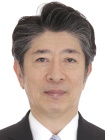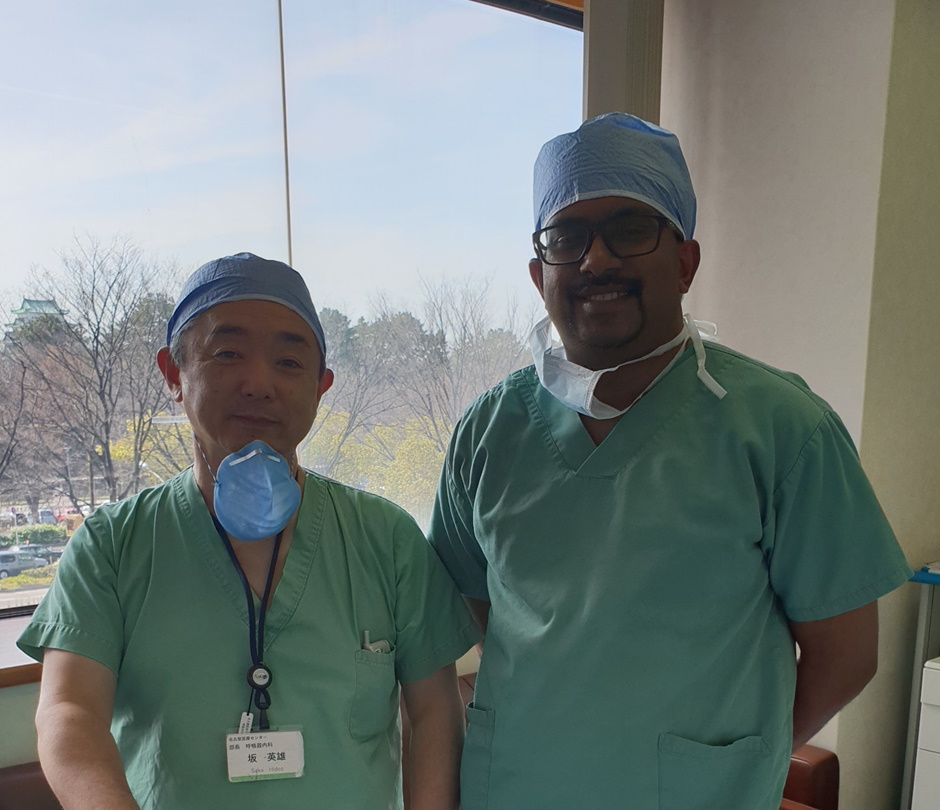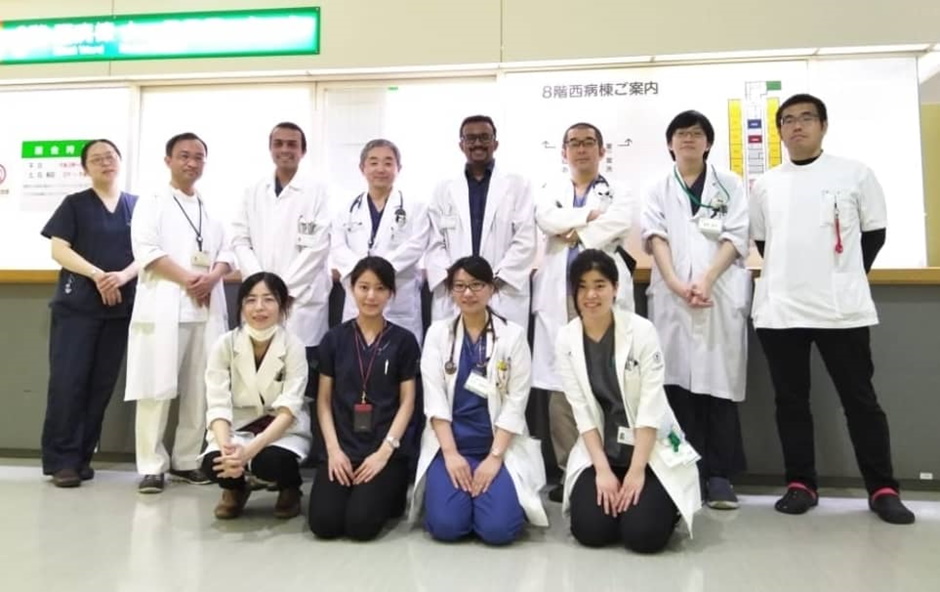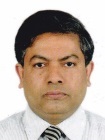
No. 134 (September 2020)


Our gratitude for your help with APSR Assembly Education Awards for Young Investigators
Dear APSR members,
On behalf of the Society, we would like to express our gratitude from the bottom of our hearts to you for your generous donations to help with APSR awards for young investigators.
By the end of June 2020, $19,705 had been collected thanks to your kind support. It can contribute to increase our educational opportunities to young researchers and enrich the contents of seminars or make them more attractive than before. This will also increase the amount for activities in promoting healthcare training, research, education and advocacy in the Asia-Pacific region.
We would like your continuous support for young doctors, and the details can be seen at apsresp.org/donation/recent-donations.php.
Again, thank you very much for your great cooperation.
Sincerely yours,
Yoichi Nakanishi
President, APSR

Post-training report by Dr Arvindran Alaga
Respiratory Department
Hospital Sultanah Bahiyah,
Alor Setar, Kedah
Malaysia
| Research/training: | Visiting and Attending Researcher on Bronchoscopy and other related areas (Interventional Pulmonology Fellowship – Adult Respiratory Medicine) 1 April 2020 – 31 July 2020 |
| Host institute: | Department of Respiratory Medicine National Hospital Organization, Nagoya Medical Center |
| Host supervisor: | Dr Hideo Saka MD, FCCP Dr Masahide Oki MD, PhD, FCCP |
It was an honour to be awarded APSR short term Research/Training Scholarship which aided me in enrollment for my attachment in Respiratory Department of Nagoya Medical Center, Japan. Nagoya Medical Center is a tertiary referral centre for interventional pulmonology procedures. It was a blessing to have Dr Hideo Saka and Dr Masahide Oki (both are well known interventional pulmonologists regionally and internationally) who directly supervised and coached me.
During my attachment in the department, I had an opportunity to participate in a wide range of interventional pulmonology procedures such as radial EBUS, linear EBUS, EUS, EUS-B, rigid bronchoscopy, peripheral bronchoscopy, navigational bronchoscopy, stenting (silicone/metallic including complex stenting procedures), cryobiopsy, medical thoracoscopy, flexible bronchoscopy and bronchial thermoplasty.
Besides that, I had the opportunity to take part in Department CME and teachings, daily X-ray conference, weekly follow-up conference on research and grand ward rounds. I had the opportunity to co-author a paper on Relapsing Polychondritis and broaden my skills on reviewing the journals.
The department has wonderful fellows and consultants who were friendly and helpful throughout my stay in Japan. I would like to convey my gratitude to APSR for the Short-Term Research/Training Scholarship which enabled me to gain invaluable experience which can be used to give excellent care for patients in North Malaysia.
My sincere thanks to my Home Supervisor Dr Razul Md Nazri who has been supportive in my endeavours. In a nutshell, it was a lifetime experience for me in Nagoya, a city which is rich in culture, history and definitely a beautiful place with kind souls.
Click any photo to enlarge


"A good teacher / supervisor can inspire hope,
ignite the imagination and instil a love of learning"
See a collection of COVID-19 material on the dedicated COVID-19 page on the APSR website.

In the current pandemic, where face-to-face meetings and conferences cannot be held, the value and importance of journals is greatly increased.
Therefore we are pleased to relay the news that Dr Madegedara, Head of the APSR Clinical Respiratory Medicine Assembly, has recently taken up the post of associate editor of ERJO, in addition to his role as Scientific Chair and Editor in Chief of Respire (the official journal of the Sri Lanka College of Pulmonologists) and President of the Kandy Society of Medicine.
Please continue to support him and all others working hard to publish high quality content, by submitting your articles for consideration.
The APSR's own Respiratory Updates is taking a short break during the pandemic, but Respirology and Respirology Case Reports continue to flourish and accept submissions.
The latest issues follow:
Respirology Vol. 25 Issue 9 - Interventional Pulmonology Pearls
Respirology Case Reports Volume 08 Issue 7
The spotlight this month is on
Each month we share details of activities of a particular country, region or society.
If you would like the spotlight to be on your country, region or society next month, contact the Bulletin Coordinator or APSR Secretariat.
The KATRD International Conference 2020 will be held virtually on 12-13 November 2020.
As the global impact of the coronavirus pandemic grows daily, the priority is always the health and safety of our community and participants.
The KATRD has developed into an international academic conference thanks to your efforts and support. Last year, the conference attracted 1,067 participants from 20 countries. The KATRD will build a dynamic, interactive, and inclusive virtual conference.
Internationally renowned speakers will be in attendance to discuss the latest trends with plenary sessions and symposiums which will cover all areas of our rapidly changing medical environment. Throughout these programmes, the Conference will offer exciting opportunities to gain insights and new ideas as you are connected to globally well-known speakers and enthusiastic fellow scholars. This Conference hopes to build an international network and promote collaboration.
The registration fee has been substantially reduced to encourage students and trainees from non-presenting attendees from all over the world to attend the conference on a new digital meeting platform.
| Registration fee | |||
| Early (until 16 October) | Late (after 16 October) | ||
| Medical Doctor, Professor | Domestic | KR₩ 20,000 | KR₩ 50,000 |
| Overseas | US$ 20 | US$ 50 | |
| Fellow, Resident, Nurse, Military Doctor, Researcher, etc. | Domestic | KR₩ 10,000 | KR₩ 30,000 |
| Overseas | US$ 10 | US$ 30 | |
Registration will provide each participant with an access code to participate in sessions.
The date has changed for the World Congress of Bronchology & Interventional Pulmonology (WCBIP), biennial flagship international congress of the WABIP (World Association of Bronchology & Interventional Pulmonology).
This had been scheduled to be held in Shanghai, China, on 16-19 April 2020 and has been postponed to 19-22 November 2020 due to the coronavirus pandemic.
Please check the WABIP webpage www.wabip.com/congress for the latest details.
The date has changed for the 60th Annual Meeting of the Japanese Respiratory Society
This had been scheduled to be held in Nagoya on 24-26 April 2020 and has been postponed to 20-22 September 2020 due to the coronavirus pandemic. The venue has also been changed and the Annual Meeting will now be held at the Kobe Convention Center, Japan.
Please check the JRS webpage www.jrs.or.jp/jrs60/en/index.html for the latest details.
Also due to the pandemic, the date of the World Conference on Lung Cancer has changed.
This had been scheduled to be held on 9-12 August 2020 and has been postponed to 26-29 January 2021.
Please check the IASLC website wclc2020.iaslc.org for the latest details.
The Global Health Challenges for the New Decade
This virtual conference was hosted by Rajavithi Hospital, Rajavithi Hospital Foundation, Thailand on 15-17 July 2020.
The 'COVID-19 Global Health Challenges for the New Decade Virtual Conference' was held to assemble the experts in the expanding fields related to the COVID-19, from very fundamental issue to "new normal" practical approach and vaccine development. We are all acutely aware of the growing crisis associated with the Coronavirus. Thus it is timely that this meeting was held to enable all front liners in this battle to meet and discuss critical issues in this escalating problem. This 3-day virtual conference had gathered 27 invited speakers from around the world including the UK, Vietnam, Philippines, Indonesia, USA, China and Thailand.
These experts covered the fields of laboratory, diagnosis, critical care, infection control and treatment, paediatric issues, crisis and hospital management and vaccine. It attracted almost 1,000 participants from around the world. The Opening Ceremony was presided over by Dr Somsak Akkasilp, Director General, Department of Medical Services.
International sessions were held on the first day, followed by two days of Thai sessions. See the full programme here

A 30-minute video recording of her presentation is streamed here.

A 20-minute video recording of her presentation is streamed here.
Podcasts of both sessions are available at anchor.fm/apsr
See Respirology's article: Letter from New Zealand doi/10.1111/resp.13931 published last week, which complements the following BBC News extract.
New Zealand has put its largest city back into lockdown after recording four new Covid-19 cases, ending a 102-day streak without a local infection. >A three-day lockdown was swiftly imposed in Auckland after the cases were confirmed. The four new cases are all members of a single family. None had travelled recently.
The restrictions will come into effect on Wednesday [12 August], as authorities scramble to trace contacts of the family. Auckland residents will be asked to stay at home, large gatherings will be banned, non-essential businesses will be shut, and some social-distancing restrictions will be reintroduced in the rest of the country.
The country's Prime Minister Jacinda Ardern also on Wednesday deferred the dissolution of parliament, following the latest Covid-19 cases. The dissolution of parliament, which is required to make way for a general election, has now been deferred until Monday.
Ms Ardern said no decision had yet been made on postponing the election - originally scheduled for 19 September. "We have some time to work through that," she said, according to a TVNZ report.
New Zealand has fared better than other countries, recording 1,220 confirmed cases and 22 deaths since the virus arrived in late February. Before Tuesday, New Zealand had gone 102 days without recording a locally transmitted case of Covid-19, one of the few countries to reach such a milestone. All 22 active cases of the virus before Tuesday's announcement were among returning travellers quarantined in isolation facilities.
Praised internationally for its handling of the pandemic, the country's government had lifted almost all of its lockdown restrictions, first imposed in March. An early lockdown, tough border restrictions, effective health messaging and an aggressive test-and-trace programme have all been credited with virtually eliminating the virus in the country. But as infections continue to rise across the world, surpassing 20 million globally on Tuesday, New Zealand officials have warned against complacency.
Announcing the lockdown, Ms Ardern said it was necessary to go hard and go early to stamp out the virus. Auckland - a city of around 1.6 million people - would move to level three restrictions from 12:00 local time on Wednesday as a "precautionary approach", she said.
The prime minister said the rest of the country would move to level two of New Zealand's 4-tier alert system of measures against Covid-19. "This is something we have prepared for," Ms Ardern said at a news conference.
"We have had 102 days and it was easy to feel New Zealand was out of the woods. No country has gone as far as we did without having a resurgence. And because we were the only ones, we had to plan. And we have planned," she said.
Director-General of Health, Dr Ashley Bloomfield, said at least three days of lockdown were needed in Auckland to trace the source of the new cases. "We're expecting to see other cases," Dr Bloomfield said. "We want to find those other cases as soon as possible and identify or isolate any contacts."
Michael Baker, professor of Public Health at the University of Otago, told BBC's Newsnight programme that even with the most successful strategies in dealing with the coronavirus outbreak "one thing you have to plan for is setbacks".
"I think New Zealand will succeed and get rid of the virus," he added.
In anticipation of a pre-lockdown rush to supermarkets, Ms Ardern and the mayor of Auckland, Phil Goff, called for calm, saying there was no need to panic-buy.
Despite their pleas, large crowds of shoppers were seen queuing at supermarkets on Tuesday night, as they attempted to stock up before lockdown. One video posted to social media shows customers streaming through the door of a supermarket as a security guard tries to prevent them from entering.
The World Health Organization (WHO) had hailed New Zealand as an example to others for having "successfully eliminated community transmission". But other countries have had early success in suppressing the virus, only to see infections rise again after lifting lockdown restrictions that damaged the economy.
Vietnam went 99 days with no community transmission until July, when a 57-year-old man in Da Nang tested positive for the virus. By the end of July, Da Nang was the epicentre of a new coronavirus outbreak, leading to the country's first coronavirus death since the pandemic began.
Australia, too, has seen a resurgence of Covid-19 in some states, including New South Wales and Victoria, where a strict lockdown has been imposed.
Extracted from BBC News 12 August 2020
bbc.com/news/world-asia-53741091
By Preeti Jha
BBC News
In mid-July, Vietnam still shone as a Covid-19 outlier. No reported deaths, and months without a locally transmitted case. Fans packed into football stadiums, schools had reopened, and customers returned to their favourite cafes. "We were already back to normal life," said Mai Xuan Tu, a 27-year-old from Da Nang in central Vietnam.
Like many in the coastal city wildly popular with domestic visitors, she works in the tourism industry and was slowly resuming bookings for the tour company she founded. But by the end of July, Da Nang was the epicentre of a new coronavirus outbreak, the source of which has stumped scientists. Cases suddenly surged after 99 straight days with no local transmissions. Last week the city saw the country's first Covid-19 death, a toll that has since risen to 10.
Just weeks earlier, Vietnam was praised globally as a rare pandemic success story. The communist country acted fast and decisively where other nations faltered, closing its borders to almost all travellers except returning citizens as early as March. It quarantined and tested anyone who entered the country in government facilities, and conducted widespread contact-tracing and testing nationwide.
So what went wrong?
"I'm not sure anything went wrong," says Prof Michael Toole, an epidemiologist and principal research fellow at the Burnet Institute in Melbourne.
Most countries that thought they had the pandemic under control have seen resurgences, he says, pointing to a long list including Spain, Australia and Hong Kong. "Like in the first wave, Vietnam has responded quickly and forcefully."
Around 80,000 visitors in Danang - many of whom had relaxed into thinking the disease was contained - were flown home promptly after the new cases emerged, as the historic port city sealed itself off from visitors and retreated into full lockdown. Vietnam's spike shows that "once there's a little crack and the virus gets in it can just spread so quickly," Prof Toole says.
Scientists and researchers across the country are racing to find out exactly how it did. In Hanoi Prof Rogier van Doorn, director of the Oxford University Clinical Research Unit, says the source of this latest outbreak remains a "big mystery". His team works with the government on its infectious diseases programmes and some of them focus on what he calls "genetic detective work" - the sequencing of viruses that can help illuminate "the chains of transmission. Who or where the virus came from". But so far no-one knows how the first new case in Da Nang - a 57-year-old man known as patient 416 - came into contact with the coronavirus.
The knowledge gap has allowed some speculation to set in. Local media have carried reports suggesting the latest outbreak may have been caused by a more virulent strain of the virus. Others have pointed to recent people-smuggling cases along the Vietnam-China border. But there is no evidence to suggest a more deadly strain or that migrants have brought the virus into the country.
A more likely possibility, say researchers, is that the virus went undetected during the months where there were no reported cases, potentially being asymptomatically transmitted in the community. Or there could have been an error somewhere along the quarantine process with someone released prematurely.
"There's evidence [the virus] was circulating in Da Nang for several weeks before that first case was diagnosed," says Dr Justin Beardsley, a senior lecturer in infectious diseases at the University of Sydney whose research has focused on Vietnam.
There could be some element of people dropping their guard, he adds, while noting that Vietnam showed exceptionally strong community engagement when it came to curbing spread of the virus. "There was big national pride about controlling the pandemic. And I think that's been missing in some Western countries.
Since hovering around the 400 mark in late July, the number of confirmed coronavirus cases in Vietnam has surged above 780. The deputy health minister has said they expect numbers to rise and forecast on Wednesday that the epidemic will reach a peak in 10 days.
With the recent tourists to Da Nang now back at home, cases have been detected in a total of 14 cities and provinces including the capital and Ho Chi Minh City. But it has been reassuring, says Prof Van Doorn, that all new cases in other parts of the country so far have had a direct link to the Da Nang outbreak. Crucially, there has been no reported community transmission outside of the city and bordering province. This is something authorities will be monitoring closely. "What was successful before is being done again. I'm again impressed," he adds.
Speckled among the praise showered on Vietnam for its handling of Covid-19 were some questions about the accuracy of the authoritarian state's data, which medical and diplomatic communities had widely agreed was reliable.
"The new deaths reported shows that there is transparency in reporting Covid-19 in Vietnam and that previous 'no deaths' should have not been questioned in the first place," Dr Huong Le Thu, a senior analyst at the Australian Strategic Policy Institute, tells the BBC. All the fatalities so far have been older patients with co-morbidities.
In Da Nang residents are readjusting. The beaches and streets are virtually empty once again as people only leave home to buy food. All eateries have been closed, including for takeout and deliveries. Flights are grounded. Each resident is set to be tested for the virus, and a field hospital has been erected as every resource is thrown at slowing the spread of the disease.
Freedoms mostly remain intact in other parts of the country, though Hanoi has closed down bars and karaoke parlours as an extra precaution, and several cities including the capital and Ho Chi Minh City have made face masks compulsory again in public places.
Like many worldwide, Xuan Tu is rolling with the uncertainty triggered by the pandemic. "This year is now the year we look after our health. Focus on family. The things that are most important," she says.
Extracted from BBC News 8 August 2020
bbc.com/news/world-asia-53690711
Respirology and Respirology Case Reports have published article collections in support of World Lung Day and can be found here:
The Forum of International Respiratory Societies (FIRS) have prepared a series of fliers in different languages.
Click any image to enlarge and copy.

The APSR is pleased to offer support for an En Bloc Society - APSR Joint Symposium each year at the En Bloc Society's annual conference.
The model is a Joint Symposium with a theme and topics proposed by the En Bloc Society and agreed with the APSR.
The En Bloc Society will host the event, and organise the schedule and room for a 2- to 3-hour educational symposium, generally with 30-minute talks by 4 to 6 Speakers accordingly. Half of the Speakers will be from the En Bloc Society and half will be APSR Speakers
APSR Speakers will give their talks in English. En Bloc Societies organise high quality conferences, which are increasingly appealing to international audiences as more are using English as their main language
APSR members from different countries might attend these conferences as Speakers or delegates
Joint Symposia may encourage other APSR members and their students/trainees to attend and participate, therefore increasing collaboration and cooperation between respirology health care workers and researchers in the AP region by building new networks for the future
En Bloc Societies are key to fulfilling the APSR mission and vision. Increased regional cooperation will strengthen respirology in the AP region.
The En Bloc Society will:
The APSR will:
Please feel free to contact education@theapsr.org if you have any queries.
The Teaching Library is open for your self-study. Challenging yourself to choose the correct procedure for any of the 122 cases in the Library at apsresp.org/education/teaching-library/index.php.
Many more cases are needed for this Library and any member is welcome to submit a case through the same link as above.
The following members have kindly sent their donation towards the Society's goals, as outlined at apsresp.org/members/donors.php.
The APSR is profoundly grateful for their generosity.
Congratulations to the following members who have recently become Fellows of the APSR:
A warm welcome to the following members who have recently joined or re-joined APSR assemblies.
| Dr Govindasamy Chinnasamy | Bronchoscopy and Interventional Techniques COPD Lung Cancer |
| Dr Sajal De | Clinical Respiratory Medicine |
| Dr Anil Kumar Gandham | Bronchoscopy and Interventional Techniques Respiratory Infections (non-tuberculous) Critical Care Medicine |
| Dr Vanitha Gnanasoundran Sundarasamy | Tuberculosis Clinical Respiratory Medicine Bronchoscopy and Interventional Techniques |
| Dr Sharad Joshi | Bronchoscopy and Interventional Techniques Interstitial Lung Disease Respiratory Infections (non-tuberculous) |
| Dr Muralidhara Reddy Kona | Clinical Respiratory Medicine Asthma Tuberculosis |
| Dr Petru Emil Muntean | Clinical Respiratory Medicine Respiratory Infections (non-tuberculous) Tuberculosis |
| Dr Peter Wark | Asthma COPD Respiratory Infections (non-tuberculous) |
| Dr Sally Wootton | COPD Interstitial Lung Disease Lung Cancer |
Here are the main respiratory events in Asia-Pacific region for the next few months. You can see our full listing on the APSR Calendar.
For more pulmonology events, see apsresp.org/calendar.html
(These events are for information only and APSR endorsement should not be assumed.)
If you have news of interest to APSR members, please send details to one of the Bulletin Coordinators: Prof. A Azuma (a-azuma@nms.ac.jp) or Prof. C K Rhee (chinkook77@gmail.com).